COVID Immunity: The Road Ahead
This week, we are boosting our knowledge on what "immunity" against COVID-19 really means and what our strategy heading into winter should be. We’ll also hear about a new generation of coronavirus vaccines to better protect us in future. Plus, in the news, signs that living through the pandemic is having a serious impact on early childhood development, leaded petrol disappears from the last service stations, and the new wooden floor that generates electricity when you walk on it...
In this episode

01:05 - IQ drop in pandemic-born infants
IQ drop in pandemic-born infants
Sean Deoni, Brown University
Last year over 615000 babies were born in the UK, most of them during the Covid-19 pandemic. Those infants have been brought up in home environments and lived lifestyles that will have been dramatically different from the experiences of children a few years older. For many, there've been none of the normal parent and baby groups, no nursery days or playdates, no contact with grandparents, and mums and dads facing a lot more stress than normal. And there's worrying signs that this is having a detrimental impact on how these young babies are developing. Sean Deoni, from Brown University, has followed over 800 children during the last decade, assessing their mental and physical progress up to the age of three. 120 of his study subjects were born during the pandemic, so he's been able to compare their performances with the more than 600 born before Covid-19 struck and the results are quite worrying...
Sean - What we were basically finding is that when we look across all those kiddos, we found a dramatic reduction in the abilities and skills that the children who've been born since the pandemic have - you know, language abilities, your ability to understand words and say words, the ability to crawl, roll over, all those sorts of things have been dramatically reduced. When we think about what a child at about six months of age, seven months of age, eight months of age have used to be able to do, these children just are not achieving that level. Typically we grade scores on a value of a hundred, and so normally our children are about, you know, between 95, 105, that sort of range kids born since the pandemic are down around the 78 to 80 range. So a significant reduction in what they're able to
Chris - And to what do you attribute this?
Sean - That's the million dollar question in a way, and so we've been trying to understand that and look into the data. Certainly I think a lot of it comes down to the environment that the children are growing up in. So just the lack of being able to go outside, play - being in playgroups at daycares, interaction with their parents, all those sorts of things have been reduced over the last year. As well as just the overall stress of the environment, so parents making sure that they still have jobs, are still able to afford food and housing and whatnot. So all that stress on the parents, which takes away time from their ability to play with their children or spend time with their children. It's really that whole environmental aspect that's been fundamentally changed. And I think that's what's driving a lot of these things we're seeing
Chris - One newish mother asked me the other day about the impact of face coverings and young babies, seeing their mum or dad's face and facial expression and the impact for language development.
Sean - Absolutely. So there's no question that one of the biggest things that we have in our games and tests that we do in kids before and after the pandemic has been that our team is wearing masks. And as you say, you typically sort of think about that in terms of language, right? Can they see your facial expressions? Can they see how your lips are moving as you're making words? What I think is surprising in our results is that we're seeing these deficits in motor aspects. So things like crawling, standing up, walking, taking first steps. So things that you wouldn't normally associate with those facial expressions. And so, although masks are probably playing an important role, it's not the only thing that's coming into this.
Chris - Can you rule out mothers catching coronavirus when they're pregnant? I mean, could that be a contributor here, that the illness in the mother is in some way affected. Almost like a congenital problem, like Zika, do you think that could be a component or did you rule that out in the study?
Sean - So these kids were all born to moms who were healthy during pregnancy. Although when we talk about healthy, this is self-reported. So the mothers may have been asymptomatic, but didn't know. So that's certainly a possibility, but in general, most of these children and their mothers were healthy during pregnancy. So much more of an impact of just the environmental changes at this point.
Chris - And, do you think this is permanent? Because obviously the question that's going to be going through many new parents' minds, having heard what you're saying is "my goodness, is my child damaged forever?" Do you think the children will catch up?
Sean - Well, that's definitely the billion dollar question. And I certainly think, you know, this isn't to be alarmist by any stretch. I think this is a single study, a single finding, that raises questions and raises the possibility. I don't think that these things are permanent by any stretch. You know, children are incredibly resilient. And we talk about that resilience a lot. That said, we also talk about the importance of the first thousand days. We hear that a lot, right? The importance of those first two years of life in setting up those long term trajectories of development and pathways of health. And so the window of opportunity for having really solid interventions, and kind of course correcting for this, is now. And so I think this is the time to be acting. So again, not to be alarmist, but at the same time, you know, if there are things that we can be doing, playing with our children, getting back together, you know, this is the time, better sooner than later.
Chris - What advice can you offer parents then? Especially if they're just about to have a baby, to make sure that their children have the least risk of the sorts of changes you're seeing here happening to them.
Sean - That's a great question as well. And you know, we're certainly not here to give sermons and whatnot, but at the same time, I think when it comes down to it, it all comes down to playing with your child, right, love your child. And if you do that, you'll end up playing with your children, interacting with them, stimulating them, and both helping your mental health as a parent, but also helping their mental health and their development. So even if we can squeak out those 10 minutes between Zoom calls, that half an hour to an hour for bath time and reading time before bed, all those sorts of little things really add up and make a huge amount of difference. Similarly, getting outside, getting out to playgrounds, play, interact with other families, and just trying to get back to that environment that we all had as kids and that kids had even a couple of years ago.

07:18 - An end to leaded petrol
An end to leaded petrol
Rob de Long, United Nations Environment Programme
This month it’s smiles all round as the world is finally rid of leaded petrol. After 20 years of campaigns and close collaboration between international groups, Algeria, the last country still pumping leaded fuel, finally switched fully to unleaded. But why did we use leaded petrol in the first place, and how was it putting us at risk? Eva Higginbotham spoke to the United Nations Environment Program’s Rob de Long...
Rob - So some decades ago the whole world was using leaded petrol because in the early 20th century, around the 1920s, it found out if you add some lead to fuel, it will increase its octane, which means that it will prevent pre ignition in the cylinders and the engine will just run much better. So when they found that out, basically all fuel in the world, all petrol in the world they started adding lead. And in the 1960s and 70, the whole world, all the fuel used was this leaded fuel.
Eva - And what's the problem with adding lead?
Rob - The problem with adding lead is that it doesn't combust in the engine, but it works as a catalyst. So it goes out with the exhaust into the atmosphere. And of course, where our cars are driving, people are breathing, so everybody was breathing these small lead particles that were nicely dispersed through car exhausts. And breathing in that lead, it goes in your lungs and even through your lungs, into your blood. And in the sixties and seventies, or fifties and sixties I would say, it was found that this lead in your blood is really bad for your body and has multiple health impacts. Actually, doctors say that there's not a single part in your body that is not negatively affected by the fact that you will lead in your blood.
Eva - So we tried to move away from lead because it was having bad health effects on the people who live nearby.
Rob - That's not the only reason. So it was indeed having serious health effects, but it was also preventing the mental development of children's brains. And so that was also known to restrict the mental development, and children growing up in an environment where leaded petrol was used were shown to have between 5 and 10 IQ points less. And a third reason is that in the seventies, filters were invented that can filter out the exhaust, they're called catalytic converters, and are now standard in every car. But those catalytic converters cannot run with leaded petrol, and so those filters that can filter 80 to 90% of pollution from cars could only work when we would switch to fuel without that.
Eva - So how did that transition get started, moving from everyone having leaded petrol, to away from that?
Rob - You can imagine it was a major transition. Every single car in the world was going around on leaded petrol and now we had to go to unleaded petrol. And that worked quite quickly in the developed world - in the eighties and seventies, eighties, and nineties, most of the developed countries banned the adding of lead to fuel and soon they were unleaded. However, at the beginning of the 21st century, there were still more than 100 countries using leaded petrol, and almost all of them were in low and middle income countries where these programs had not been started.
Eva - If you need the lead to make the engines work better, how have we now gotten away with not using it?
Rob - There are different ways to compensate for removing the lead. The most common way is you change the refinery process - that needs some investment. And the fuel that you produce - a fuel is a mixture of different components, the components are slightly different - and you can then increase the octane with changing the refinery process, increase the quality of the fuel, increase the octane level. There's also other possibilities. You can add another additive instead of lead, ethanol or manganese. So there are different ways that developed countries managed basically to completely eliminate leaded petrol and keep the same quality of fuel.
Eva - And what were some of the challenges in getting to the final transition of no one using leaded petrol?
Rob - Well there were a number of challenges for low and middle income countries, the global south ,to follow the developed countries. Some of these challenges were one, there was a lack of awareness among consumers. So people have been driving around using leaded petrol for decades, and now this product came, unleaded, it was costing slightly more. They were known to it, and there was no communication about why they should take this. Another issue was that there was resistance from local oil traders and the chemical industry to stop using this additive. People were making a profit out of it, and they were trying to stop it. And there were these myths going around - when you had a very old fleet of vehicles, you couldn't use this new modern fuel, your cars would break down. Your engines would break down. In many countries we worked with over the years, ministers and decision-makers said, well, unleaded is nice for the developed countries, but in our case, when we have an old fleet, our cars can't take it. These are all not true. These are myths. And we debunked them with publications and showing that actually it did work, but it took a bit of time and a bit of effort. In addition to that, the producers of the additive, they actually bribed some government officials to keep buying the lead additive and keep adding it to fuels. And so some of these countries, their refineries, they created huge stockpiles. So those were a number of challenges we had to overcome in the past years to get the whole world to move to unleaded petrol
Eva - What sort of benefits can we expect moving forward then?
Rob - Studies have shown that switching to unleaded petrol saves an estimated 1.2 million premature deaths every year. So this is a major environmental success and health success. But also the impacts were also economic impacts, there were impacts even on crime rates - stopping with leaded petrol crime rates dropped dramatically 20 years after we stopped exposing our children to leaded petrol and affecting their brains. So there are many, many major impacts of this campaign that we today basically closed because there is no more leaded petrol in the world. At least no more automotive leaded fuels.

13:59 - 'Hospital of the future' finalists
'Hospital of the future' finalists
Simon Wolfson, Wolfson Economic Prize, Sue Robinson, University of Cambridge
Over the last year, the NHS has faced probably the biggest challenge in its 70 year history due to the Covid crisis. This has served to highlight strengths, but also deficiencies and weaknesses that should be addressed to improve the quality of healthcare and build a better service. This is precisely the goal of this year's Wolfson Prize, which has invited professionals to submit proposals for blueprints for the "hospital of the future". Earlier in the year we heard from Lord Simon Wolfson, when he announced that call, on what the prize is seeking to achieve...
Simon - 3.7 billion pounds is about to be invested in UK hospitals. A lot of our hospitals are hugely outdated. The thing that concerns me is that we don't just build more of the same or slightly improved versions of the past. But if it is what we're looking for is ideas as to how to build a hospital of the future. And we're looking to improve absolutely every aspect of the hospital experience, whether that be the patient experience, the clinical outcomes, staff wellbeing and the way that the hospital integrates with the healthcare system in its community.
Chris - The process has now reached the stage where five finalists remain Cambridge university's teaching hospital Addenbrookes is where accident and emergency consultant Sue Robinson works. She's one of them, we'll hear about her proposal shortly, but first Simon is back with us. Crucially he is not part of the judging process, so he can speak freely and impartially about the entries. What sort of a response did the prize call get Simon?
Simon - It's been a remarkable response, actually. I can't remember a prize having a greater response. We've had over 98 entries from 15 different countries, over 250 separate organisations involved in those entries. I'm including 11 NHS trusts. There really has been an overwhelming response and enthusiasm to this task.
Chris - What sorts of things did people highlight? Were they all centering on the same themes or did you get quite a range of ideas being presented?
Simon - We've got a huge range of ideas actually, and that's what's exciting. In fact, if you look at the five finalists, very different entries from each of them. Broadly speaking, what we've got across all of the entries is improvements to the operations in hospitals, the look and feel of them, a lot of thought has gone into where we should be locating hospitals and the services that should be included in them. Such as for example, GP services or laboratories and research, and those that perhaps shouldn't be included such as convalescence. A huge amount of ideas.
Chris - I suppose part of the value of this is that those ideas have come from people who are boots on the ground. Sue Robinson is one of them. Sue you run a very busy, I know I've seen the queue outside of it, A & E department. What was the thrust of your bid for the Wolfson prize?
Sue - My team focused on an adult emergency department, which we thought was at the heart of a hospital specialising in urgent and emergency care. We tried to design out waits for both patients and staff so that we could deliver improvements in many of the elements of quality that Lord Wolfson refers to.
Chris - One of the things that Simon highlighted to us when he was on the program previously was things like infection control in hospitals, and that has really come to the fore during the coronavirus pandemic. I know it's been a perennial headache for accident and emergency departments in many parts of this country, as well as many countries. So, what's part of your solution to that? Have you have come up with a way of also addressing that issue?
Sue - You're quite right, it was incredibly difficult maintaining the highest standards of infection control during the pandemic in our ed, which was designed in 1961. Yes, we did focus a lot in terms of infection control not only in terms of our layout, which meant that we could close off parts of the ed very easily, but we also enhanced our single patient rooms and we also used technology that is out there, that's just not used in the NHS to reduce the contamination, but also to reduce the waits that occur when you're trying to clean a room
Chris - Simon, have we got some way of translating these fantastic proposals, which have come from boots on the ground, they are very insightful, and making sure that actually they do get realised? These are all brilliant proposals, presumably, that's why they're finalists. Have we got a way of making sure that these ideas are actually acted on?
Simon - That's not something that is within my gift, but it is something that I know that government are very enthusiastic about, right from the secretary of state down. Of course, one of the critical things will be cost. I'm hoping that some of the entrants talk a little bit about the cost of their ideas when they come back with their final entries. But I think there is one other thing that will make an enormous difference, and that is the amount of freedom that hospital trusts are given. My view is that it's important for central government to adopt some of these ideas, but it's also important for them to give hospital trusts that are building these hospitals the freedom to experiment, to try new things, new locations, new ideas, so that some of these ideas are implemented. As with all these things, when you get great ideas that are seen to work, others adopt them very quickly.
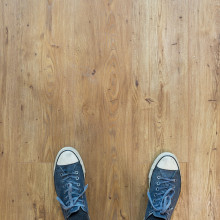
19:31 - Wooden flooring that powers the house
Wooden flooring that powers the house
Guido Panzarasa, Eidgenössische Technische Hochschule (ETH) Zürich and Swiss Federal Laboratories for Materials Science and Technology (Empa) Dübendorf
Researchers from Switzerland are jumping on their nanogenerator, for joy. The team from Eidgenössische Technische Hochschule (ETH) Zürich and Swiss Federal Laboratories for Materials Science and Technology (Empa) Dübendorf designed an A4 sized prototype of wooden flooring capable of powering small electronics and LED light bulbs. Group leader Guido Panzarasa starts us off with his vision for the nanogenerator…
Harry - Do you hear that? Yeah, that's the sound of my floorboards creaking, um, which is an ominous sign in this case. It's because the boiler leaked a little while ago and it's bloated the floorboards right up. It's not a good sound, but what happens if that sound instead could correlate with something nice, let's say savings. What happens if your floor, when walked upon could actually produce energy? Well, it could, it's called triboelectricity. Guido Panzarasa is here to explain to me exactly what that is.
Guido - From a physical point of view, the phenomenon is the same that produces a static electricity. The same kind of effect that happens when you pat a cat backwards. That's because when the 2 disimilar materials are put in contact and then separated electrons accumulate on one material, which generates an electric field, which in turn produces an electrical current. These currents can be collected and used for practical purposes.
Harry - Triboelectric materials are materials that are able to build this static energy. Is wood a good. Tribo electric material?
Guido - No. Wood is quiet terrible as a triboelectric material. It means that wood doesn't have a strong tendency, neither to attract or to lose electrical charges. Wood needs to be treated. The approach was to take advantage of the structure typical of wood.
Harry - In essence, Guido took two sheets of wood and laid them on top of one another. One of these planks was soaked in a common silicon that's known for soaking up electrons whilst nanocrystals that prefer to lose electrons were grown in the other. When the two materials are separated or press firmly together, they're in a state of equilibrium. They don't produce an electric charge. It's only when they rub against each other. It's also worth mentioning that these materials are sourced sustainably in keeping with the theme of wooden flooring. In the team's prototype the small A4 sized plank of flooring was actually able to power LEDs, small electronics, even a household lamp. But, don't be mistaken. This isn't a substitute for other renewable energy sources, but it could improve energy efficiency around the house. There's only one question left to ask, are these smart houses going to continuously cause me static shocks?
Guido - Oh no, no, no. The electricity generation mechanism will be hidden inside of the wood flooring itself. There will be absolutely no risk of getting electrocuted while walking on the triboelectric wooden floor.
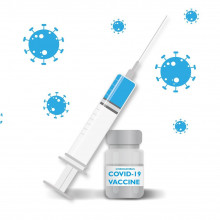
24:01 - COVID immunity: 10 months after the vaccine
COVID immunity: 10 months after the vaccine
Sarah Walker, University of Oxford
10 months after the first COVID-19 vaccine was approved in the UK, about 80% of the adult population are now fully vaccinated. What effect has this had on the transmission rates and disease reates from the new coronavirus? Chris Smith spoke to Sarah Walker, who leads the national COVID-19 infection survey, to find out...
Chris – So lots to get our head around: 10 months on what do we now know about the immunity that we get against the new coronavirus from vaccination, or even from infection, and how good are these vaccines at actually protecting us? How long does that immunity last and is our vaccination strategy the right one? Could we even build better vaccines that might improve on our present situation? Well, first let's begin with the situation as it stands. Here in the UK, about 80% of the adult population are now fully vaccinated. So what effect has that had on the transmission rates and the disease rates from the new coronavirus? Sarah Walker leads the national COVID-19 infection survey. What's the impact been, Sarah?
Sarah – I think the impact is really impossible to underestimate. Last week we estimated 1.4% of the English population were COVID positive - that's the same rate as we saw at the end of December and January at the beginning of this year, when over a thousand people were dying every day from COVID. And yet, in the hospitals, there are COVID patients, but things are holding steady. So the vaccines have been enormously effective in preventing severe disease and death.
Chris – The government were quite keen to emphasise that through vaccination the relationship between catching coronavirus and getting severe disease had been weakened, but not completely abolished. It's at least 10 times lower though, isn't it? You're very well protected against severe disease if you've been vaccinated.
Sarah – Yes, absolutely. I would stress, however, that it is something that we do need to keep an eye on. What we're also finding is that your protection from getting infected again does seem to be changing a bit with time. And obviously that's the first step to severe disease. So at the moment there's no cause for concern, but we do need to watch it carefully.
Chris – What are your figures telling you? When you look at a vaccinated population like the UK and the circulation of the infection, what do we think the performance of the vaccines is in terms of stopping the infection spreading and the difference between severe disease and just catching and transmitting on the disease?
Sarah – There are two key components. Firstly, with Delta, the vaccines are not working quite as well as they did against Alpha, but they are still doing a good job, particularly with two doses. But what we do see is that if you do get infected despite being vaccinated, which you have a much lower chance of doing, you have still got as much virus in your nose and throat as people who haven't been vaccinated. And that means, at least potentially, you've got the same chance of passing it on.
Chris – Is that what you're seeing? Do the figures bear out the idea that there are people who are catching it and transmitting it despite vaccination?
Sarah – We see highest positivity rates still in the youngest people who were mostly unvaccinated, but we certainly do see positivity rates rising in older people. And I would stress that if people didn't carry the virus for as long if they'd been vaccinated, we would expect to see lower levels in the survey, because we test people at random. If you've got a high virus level for a shorter period of time, by chance, we should pick you up less likely when you've got a high virus level. And that's not what we see. We see similar levels of virus in people vaccinated and not vaccinated who happened to get infected.
Chris – What do you foresee happening with those sorts of findings as we go into autumn and winter, when traditionally all kinds of infections spread much better because we spend more time indoors together, breathing the same air, the days are shorter, so people tend to be indoors for longer, and it's colder, so people tend to ventilate their spaces less well?
Sarah – Given that we also see that how effective these vaccines are seems to be declining a bit with time, I think it's inevitable that we will continue to see high levels of positivity, but what really matters is keeping people out of hospital and stopping them dying. I don't think anyone now thinks we're going to eliminate COVID - we've got to find a way to live with it. And that probably does mean a reasonable number of infections. We just need to make sure the NHS is still able to function and that people don't end up dying of COVID.
Chris – Do you think, to an extent, that the fact there's high levels of circulation in the population means that some people's immune systems are being reminded, because they're bumping into people who've currently got the infection and that's almost doing the government's booster programme for them?
Sarah – It's a really good point, and we certainly saw that people who had had COVID before did even better if they then got vaccinated. So vaccination and having had COVID before was better than either vaccination alone or having had COVID before alone. I think the really critical question is this issue about making sure that people avoid severe disease, and certainly for the clinically extremely vulnerable, there is still a risk there. There are still 100 people a day dying from COVID, predominantly unvaccinated, but also some people with comorbidities and the elderly. So I think the risk is always going to be there, but there's also potentially a benefit from reminding the immune system what COVID is and giving you that boost.
Chris – When you say that immunity is waning with time, is that just because we're measuring the levels of antibody we can detect in people and we're noting that the levels are dropping? Is that necessarily translating into correspondingly more cases of severe illness? Because we know the immune system works by having a memory that underpins the production of things like antibody, so even though the antibody levels might go down, you've still got that memory as a sort of foundation that your immune system can dip into in a hurry and remobilise its resources against a threat that it meets. So is it not possible that, actually, it doesn't matter that people's antibody levels are coming down a bit? They've got that immune memory, crucially, and that could protect them in the months, to possibly years, ahead.
Sarah – What we found in our study was actually looking at new infections, so it wasn't just about antibodies declining, it was actually about the rates at which people were testing positive again with COVID. But you're absolutely right, the critical thing is to avoid ending up in hospital. If you test positive again, but you avoid hospitalisation, that may well be the best outcome that we can hope for. But it is something that we just need to watch carefully, because if you look at what's happened in Israel, they have seen very abrupt increases in hospitalisations, which is obviously what we all want to avoid.
Chris – Can that be attributed to a decline in immunity? It's not down to the arrival of the Delta agent making people more sick?
Sarah – It doesn't seem to be. Certainly our study done in the UK is when we've had a lot of Delta around. I think there are some really interesting hypotheses about the fact that in Israel they used the very short dosing interval in a lot of people and whether that has also contributed, because studies have shown that actually spacing out the vaccines a bit does give your immune system more time to react better to the second dose. That may be a part of the story.
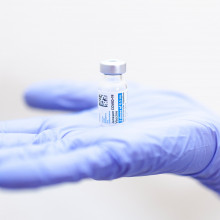
32:30 - How can you get COVID after vaccination?
How can you get COVID after vaccination?
Peter Openshaw, Imperial College London
It seems likely that the new coronavirus will continue to circulate for the foreseeable future, despite vaccination. So why are we seeing a situation where, despite vaccination, or even having caught the virus, people remain vulnerable to infection? Adam Murphy spoke to Peter Openshaw, an immunologist at Imperial College London, to find out...
Peter – It's a war between the immune system and the virus, and other viruses breakthrough having infected previously and having induced an immune response. A virus I've been working on for about 30 years called respiratory syncytial virus causes bronchiolitis, but it can still reinfect people throughout their lives, even though 96 of people have been infected by the age of three. So it's not that unusual. The one thing the immune system does is remember, the other thing it does is forget if it's not repeatedly reminded.
Adam – And that's just post vaccination with COVID-19. Can we expect it to keep happening, that more and more people become more susceptible as time goes on?
Peter – It's likely that people will become repeatedly boosted and will accumulate some pretty good immune responses over time. If we think that most of the common cold Corona viruses infect during childhood, and that is typically quite a mild infection - it just causes a bit of a common cold - and then when people are re-exposed in later life, they don't typically get very severe disease, because they've already got that immunological memory, which has been built up from that childhood exposure. This game of developing memory and maintaining or losing it is just a lifelong feature of our immune system.
Adam – Do you think we can see that sort of thing happening with COVID? That is, we will become susceptible again, but it won't be the same thing - it'll be something more cold-like than COVID.
Peter – That's what we think is probably happening, yes. This is the first time we've actually been able to watch a virus like this evolve in real time using all the tools that we have at our disposal in terms of modern immunology. It's actually quite an exciting time for immunologists and virologists to be watching all of this actually playing out - there's been a revolution really in our understanding of the immune system.
Adam – How does this work between patient groups, for example in old people versus young people or in people whose immune systems don't work as well? Do they get the same sort of benefits long term, or I suppose fewer detriments than benefits?
Peter – Yes. Well, there are people with weakened immune systems, either because they've got chronic disease or because they're on drugs that suppress the immune system, particularly people who've had transplants, who've had cancer chemotherapy - they won't develop such a good immune memory because immune memory depends on forming new cells. And if those are not being formed, because somebody is on chemotherapy, then immune memory won't develop. There's actually quite a large number of people who suffer from chronic illness, who won't develop such good immune memory. And during old age establishing good immune memory is also sometimes not so secure. So we may need to revaccinate people in order to boost their immune responses, and also maybe direct the immune response into the lining of the nose and lung, which is where we really need it. Of course, vaccines induce very good antibody in the bloodstream, but don't really inform the immune system that where it needs to focus is in the lining of the nose and lung.
Adam – You were talking there about who to vaccinate next. There's been that sort of tension between the joint committee for vaccination and immunisation (JCVI) and the government on whether we vaccinate 12 to 15 year olds or older children with health problems? Where would you fall in that line?
Peter – I think the JCVI are absolutely right to be focusing on those who will most benefit from vaccination. But remember that the brief that they've been given is really to consider the benefit to the individual, not the wider public health implications, or say, the priority that there is to get kids back into school and to try to reduce the circulation of virus in schools, because that will result in school absentees, both for the children and for the staff. So it's not part of the remit of the JCVI to consider that, and I think it's very important to appreciate that when they have made their judgment it's based really on the proven facts in relation to the individual benefit. They are quite reasonably concerned about these reports of inflammation of the heart, the myocarditis or pericarditis inflammation around the heart, which is very, very rare indeed, and actually reasonably common after COVID infection. It seems that that inflammation is probably related somehow to the actual spike protein. It's pretty mild and self-limiting actually after vaccination - I would be much more concerned that it may be more long lasting and severe if we just let the infection rip through teenagers.
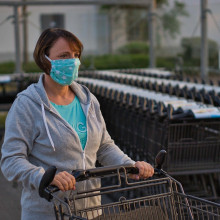
38:31 - How will the UK cope with COVID this winter?
How will the UK cope with COVID this winter?
Tim Spector, King's College London
Schools have also been told to prepare to vaccinate pupils aged 12 to 15, a group that hitherto haven't yet received an offer of vaccination, which is not the case in many other countries. So then what should our strategy be this winter? King's College epidemiologist and architect of the ZOE app that's been used to track the COVID pandemic in the UK, Tim Spector, spoke with Adam Murphy about whether there will be another lockdown this winter...
Tim - I don't see any lockdowns in the future, but I think we do have to look at what's been going on internationally and see that actually, despite all this optimism and the fact that we were so good at getting the vaccine out early, we're actually doing pretty badly on the European and international scene. And, I think to me, this is a worry that not only have we had the highest case in Europe for the last four months, but, deaths and hospitalisations are creeping up. And the current rate of deaths would put us over 40,000 a year, which we're sort of accepting as the price for having virtually no restrictions at all. Whereas most countries have a sort of halfway house. So there needs to be a change in our attitude to this. Also given the fact that these vaccines, as you said, are starting to wear off in not only, let's not forget, it's not just the old and the vulnerable, but also a lot of the healthcare staff. And that's going to take a large programme to get them back on track again.
Adam - So then what do you think is the best way forward given what we know about how the vaccine is performing?
Tim - I think first of all, we need to do as other countries have done when their rates went sky high, when kids went back to school, as we were seeing in Scotland, and I'm pretty sure we're going to see the same thing in the next week or two in England and Wales. We're already seeing it a bit in Wales. We really need to start thinking again about whether we should have thrown away all those masks and restrictions and take this much more seriously and do the simple things that we can all do to keep it under control and not have major rock festivals where 10% of people at them get infected and then go back and spread it around. We've sort of gone from the most restricted country in Europe to the most laissez faire apart from our totally out-of-context travel restrictions, which make no sense and hospitals are going to be under strain.
Tim - There's no doubt that coping with this many hospitalisations as we go into winter with other viruses on a really stressed NHS is not a great position to be in. So I think we should be prioritising boosters for the elderly, the vulnerable and the healthcare staff. And if we have spare capacity, then look at kids. But at the moment, I think it's going to be far too late for most of the kids who are going to be infected in probably in the next month before they've had any chance to have a vaccine. But these are not easy decisions as Peter has been saying. I think that it's a changing position that perhaps changes every week. But what we need to do is look much more at our international performance and see why we're doing so badly.
Adam - What about longer term, you know, monitoring, tracking, what should we be doing there?
Tim - Well, we need to keep our eyes on domestically. We should give up our ridiculous travel policy, which makes absolutely no sense when we've got the worst rates in Europe. And it's really telling people what the real symptoms are at the moment. People are completely ignorant that the real symptoms of most people getting COVID now are bad cold, flu-like symptoms, and that's contributing to the extra cases the UK is having compared to other countries. So I think it's all about much more, better information and telling the people what's really going on.
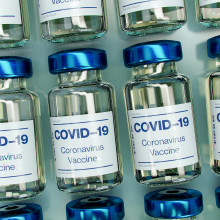
43:24 - Future-proofing against COVID-19
Future-proofing against COVID-19
Pablo Penaloza-Macmaster, Northwestern University
The vaccines we have against COVID-19 continue to work spectacularly well to protect people against severe diseases. But, as we’ve been hearing, they are less good at preventing infection and their effectiveness does drop with time. So can we improve on them to combat some of these weaknesses? That’s the goal that Pablo Penaloza-Macmaster from Northwestern University in Illinois has set for himself with what he dubs “Covid vaccine 2.0”, the next generation of Covid vaccinations, as he explained to Chris Smith...
Pablo - Most SARS-CoV-2 vaccines are based only on the spike antigen, which is the surface protein of SARS-CoV-2. And these vaccines are tremendously effective. But as you were saying, there's evidence of breakthrough infections. So we wanted to go one step further and we asked a very simple question. What if we teach the immune system, not only how the outside of the virus looks, but also how the inside of the virus looks? And for this, we gave mice this vaccine that not only expresses the outside protein of the virus, but also the inside or the guts of the virus. And what we saw is that these mice were better protected against breakthrough infections.
Pablo - And there's two reasons why we chose the nucleocapsid or the inside protein. Number one, because it is highly expressed in the coronavirus life cycle. So it's a perfect target for early detection by the immune system. But number two also because it is very stable, through many different variants and even other strains of coronaviruses, it doesn't mutate as much as the spike protein. That's the first part.
Pablo - The second part, the other piece of data, is that we have shown that SARS-CoV-1 vaccines made in 2003-2004 for the original SARS-CoV-1 also seemed to protect against SARS-CoV-2. And we have also shown in mice that some common cold coronavirus infections seem to protect mice against other coronaviruses. So what this suggests is that the vaccine does not have to be a hundred percent matched with the virus. You could have vaccines that are only 75% match, and that will still confer protection. And the follow up rationale is that it is possible to maybe make an arsenal or stockpile of vaccines based on the available known sequence of coronaviruses. And then in the future, in the case of a pandemic, we could deploy the ones that are more antigenically matched to the pandemic.
Chris - So in essence, using other parts of the virus to educate the immune system rather than just the outer coat, these spike proteins, might give the immune system more to get hold of when it's dealing with the virus. Why didn't we do that in the first place then? Why did the first generation of vaccines we're all using focus exclusively on that spike protein?
Pablo - The reason why is because data from the original SARS-1 and also MERS have pinpointed to the spike or the surface protein of the virus as being the Achilles heel. So we didn't want to take any risks. We went to the best target. And we're not saying that spike-based vaccines are worse than the nucleocapsid based vaccines. We're saying that if you combine them, it's a lot better, but if you compare them side-by-side - spike-only versus nucleocapsid-only - then the spike-only does a lot better. So people were just trying to make a vaccine very fast with the educated guess, which is based on the other coronaviruses. So that's why people focused on the spike protein.
Chris - And now you've taken it a step further. How much better is it in head-to-head trials when you do this? Admittedly, this is in mice. This is not in humans with COVID-19, but you know, we can learn a certain amount this way, can't we. How much better is it when you have the extra bit of the guts of the coronavirus, as you put it, in there alongside the spike, compared with just using a vaccine that uses the spike?
Pablo - If you compare in distal sites, for example, if you compare in the brain, it seems to be more than 10-fold better at protecting the mice from the breakthrough infection. And now we're actually trying to make it better by incorporating other vaccines. So basically, we're just trying to increase the coverage of the vaccine.
Chris - In essence then, what you might have your hand on is the ability to deal with the problem we've highlighted quite a few times in this programme, which is that at the moment we have a tool which is really good at stopping people ending up in hospital. But what it's not doing is stopping the virus circulating through society, which at the end of the day is what we really want to achieve. And with the better immunity conferred by these enhanced vaccines that you're potentially developing, we might have a way of doing that.
Pablo - Precisely. We think so.
Chris - I'm intrigued by your idea that it might also be possible to come up with a sort of pan-coronavirus vaccine, something that can counter all coronaviruses and all variants, both the knowns and the unknowns as yet. What evidence have you got that that might be achievable?
Pablo - We vaccinated mice with a SARS-CoV-1 vaccine from 2003. That is the original SARS-1. And we observed that these mice were protected against a SARS-2 challenge. That's one of the experiments. The other one is that we have infected mice with common cold coronaviruses, and then they're protected against related but different coronaviruses. So what this means is that the vaccine does not have to be 100% matched. You could have some genetic similarity, but it doesn't have to be a 100% match. So what that means is that you could potentially make a stockpile of vaccines based on the known sequences of coronaviruses, because we know a lot of different sequences. We have sequenced so many different coronaviruses. So, as long as in a future pandemic, if we pick up the right one, the right arsenal, and we take them out of the freezer - they're already made - and we take the one that is closest, genetically speaking, to the future pandemic, then we may be able to have a quick immediate response to a future pandemic.
Chris - Would you see this being realisable for this pandemic or is it too far away right now? And can we do this this time or is this going to take a lot more development?
Pablo - I honestly don't know. I think the most important thing right now is for the whole world to get vaccinated with the vaccines that we currently have available because although they don't prevent infection, they do prevent severe disease and death. So to me, that's the most important thing. So I would focus mostly on getting the whole world vaccinated.
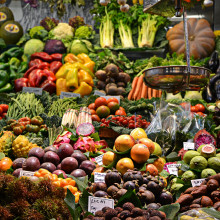
50:42 - QotW: How long before food becomes 'me'?
QotW: How long before food becomes 'me'?
Eva Higginbotham set off to find out the answer...
Eva - The first step in incorporating the food we eat into our bodies is breaking it down to its constituent parts through digestion. Carbohydrates like rice and bread break down into simple sugars like glucose, which we use as energy. We break down fats into molecules called fatty acids, which make up the membranes of our cells. And then there’s proteins: these get divided into the amino acid molecules that make them up, and our cells then use those amino acids to build and repair body tissues. There’s also minerals - things like calcium, which we absorb and use for lots of purposes, including, of course, maintaining our bones.
In terms of how long digestion takes, that depends on both the food being eaten and the person eating it. Simple carbs like white rice can get out of the stomach and into the small intestine in as little as 30 minutes, with the glucose ready for absorption into the bloodstream shortly after. But, if you eat that rice with something fatty and proteiny like peanut butter, that can slow down the process by several hours - although, now I’ve said it, rice and peanut butter sounds… interesting!
Lots of people interested in sports have studied how quickly protein is incorporated into the body from the angle of muscle building - think about the, er, delicious looking protein shakes you see people drink after going to the gym. Most of these studies have been done by radioactively labelling the proteins and then scanning the body to see where they’ve gone. Protein shakes normally contain really simple proteins, like whey or soy protein, which don’t need as much breaking down as others, and the amino acids in them have been shown to be available to the body in less than an hour.
One study showed that about 20% of amino acids consumed will go towards skeletal muscle, like those all important biceps, whereas the rest will either be excreted or used in other kinds of tissues. So, to put it simply, if you workout at the gym and drink a protein shake, within a few hours you can be pretty sure that some of those amino acids have become a part of you already. If you’re not a fan of the protein shake, another study looked at cow’s milk, and showed that, after drinking, some amino acids became available in the blood within an hour and the numbers kept rising for the next 5 hours.
In terms of how long the nutrient you ate stays part of you, that depends on where it’s gone. Some cells in your body have very high turnover, like those that line your intestines, whereas others will last for years and years and just need some maintenance. Your bones will turnover about 500mg of calcium every day, and replace it with new calcium from your diet - so it’s a good idea to keep up with those leafy greens if you’re not a fan of dairy.
So, how long does it take the food you eat to become part of you? The answer, as Dr Tristan Dew from the University of Nottingham said, is ‘not as long as you might think!’ and I certainly agree with that.










Comments
Add a comment